Global Research on Contaminated Soil Remediation: A Bibliometric Network Analysis
Abstract
:1. Introduction
2. Materials and Methods
2.1. Data Collection
2.2. Data Extraction
3. Discussion
3.1. Publication Trend
3.2. Contribution of Countries and Institutions
3.3. Characterization of Research Keywords
3.4. Evolution Trend of Co-Occurrence Keywords
3.5. Most Highly Cited Literature
3.6. Reference Co-Citation Analysis
4. Conclusions
Author Contributions
Funding
Institutional Review Board Statement
Informed Consent Statement
Data Availability Statement
Conflicts of Interest
References
- Lee, H.-G.; Kim, H.-K.; Noh, H.-J.; Byun, Y.J.; Chung, H.-M.; Kim, J.-I. Source identification and assessment of heavy metal contamination in urban soils based on cluster analysis and multiple pollution indices. J. Soils Sediments 2021, 21, 1947–1961. [Google Scholar] [CrossRef]
- Lepak, J.; Shayler, H.; Kraft, C.; Knuth, B. Mercury Contamination in Sport Fish in the Northeastern United States: Considerations for Future Data Collection. BioScience 2009, 59, 174–181. [Google Scholar] [CrossRef]
- Meena, R.S.; Kumar, S.; Datta, R.; Lal, R.; Vijayakumar, V.; Brtnický, M.; Sharma, M.; Yadav, G.; Jhariya, M.; Jangir, C.; et al. Impact of Agrochemicals on Soil Microbiota and Management: A Review. Land 2020, 9, 34. [Google Scholar] [CrossRef]
- Yin, X.; Feng, Q.; Li, Y.; Deo, R.C.; Liu, W.; Zhu, M.; Zheng, X.; Liu, R. An interplay of soil salinization and groundwater degradation threatening coexistence of oasis-desert ecosystems. Sci. Total Environ. 2022, 806, 150599. [Google Scholar] [CrossRef]
- Hongbo, S.; Liye, C.; Gang, X.; Kun, Y.; Lihua, Z.; Junna, S. Progress in Phytoremediating Heavy-Metal Contaminated Soils. In Detoxification of Heavy Metals; Sherameti, I., Varma, A., Eds.; Springer: Berlin/Heidelberg, Germany, 2011; pp. 73–90. [Google Scholar]
- Dales, J.H. Pollution, Property & Prices: An Essay in Policy-Making and Economics; Edward Elgar Publishing: London, UK, 2002. [Google Scholar]
- Gooden, J.; T Sas-Rolfes, M. A review of critical perspectives on private land conservation in academic literature. Ambio 2020, 49, 1019–1034. [Google Scholar] [CrossRef]
- Azubuike, C.C.; Chikere, C.B.; Okpokwasili, G.C. Bioremediation techniques–classification based on site of application: Principles, advantages, limitations and prospects. World J. Microbiol. Biotechnol. 2016, 32, 180. [Google Scholar] [CrossRef]
- Paul, N.; Albrecht, V.; Denke, C.; Spies, C.D.; Krampe, H.; Weiss, B. A Decade of Post-Intensive Care Syndrome: A Bibliometric Network Analysis. Medicina 2022, 58, 170. [Google Scholar] [CrossRef]
- Pritchard, A. Statistical Bibliography or Bibliometrics? J. Doc. 1969, 25, 348–349. [Google Scholar]
- Yu, S.; Cui, B.; Xie, C.; Man, Y.; Fu, J. Bibliometric Review of Biodiversity Offsetting During 1992–2019. Chin. Geogr. Sci. 2022, 32, 189–203. [Google Scholar] [CrossRef]
- Usman, M.; Ho, Y.-S. A bibliometric study of the Fenton oxidation for soil and water remediation. J. Environ. Manag. 2020, 270, 110886. [Google Scholar] [CrossRef]
- Zhang, S.; Mao, G.; Crittenden, J.; Liu, X.; Du, H. Groundwater remediation from the past to the future: A bibliometric analysis. Water Res. 2017, 119, 114–125. [Google Scholar] [CrossRef] [PubMed]
- Guo, K.; Liu, Y.F.; Zeng, C.; Chen, Y.Y.; Wei, X.J. Global research on soil contamination from 1999 to 2012: A bibliometric analysis. Acta Agric. Scand. Sect. B—Soil Plant Sci. 2014, 64, 377–391. [Google Scholar] [CrossRef]
- Mao, G.; Shi, T.; Zhang, S.; Crittenden, J.C.; Guo, S.; Du, H. Bibliometric analysis of insights into soil remediation. J. Soils Sediments 2018, 18, 2520–2534. [Google Scholar] [CrossRef]
- Fakhar, M.; Keighobadi, M.; Hezarjaribi, H.Z.; Montazeri, M.; Banimostafavi, E.S.; Sayyadi, S.; Hamadani, M.M.G.; Sharifpour, A.; Tabaripour, R.; Asadi, S.; et al. Two decades of echinococcosis/hydatidosis research: Bibliometric analysis based on the web of science core collection databases (2000–2019). Food Waterborne Parasitol. 2021, 25, e00137. [Google Scholar] [CrossRef]
- Nisha, N.B.; Varghese, R. Literature on Information Literacy: A Review. DESIDOC J. Libr. Inf. Technol. 2021, 41, 308–315. [Google Scholar]
- Tan, H.; Li, J.; He, M.; Li, J.; Zhi, D.; Qin, F.; Zhang, C. Global evolution of research on green energy and environmental technologies: A bibliometric study. J. Environ. Manag. 2021, 297, 113382. [Google Scholar] [CrossRef]
- Cai, Q.-Y.; Mo, C.-H.; Wu, Q.-T.; Katsoyiannis, A.; Zeng, Q.-Y. The status of soil contamination by semivolatile organic chemicals (SVOCs) in China: A review. Sci. Total Environ. 2008, 389, 209–224. [Google Scholar] [CrossRef]
- Noyons, E. Using bibliometric maps of science in a science policy context. Em Questão 2012, 18, 15–27. [Google Scholar]
- Chen, C.; Dubin, R.; Kim, M.C. Emerging Trends and New Developments in Regenerative Medicine: A Scientometric Update (2000–2014). Expert Opin. Biol. Ther. 2014, 14, 1295–1317. [Google Scholar] [CrossRef]
- Zhang, H.; Yuan, X.; Xiong, T.; Wang, H.; Jiang, L. Bioremediation of co-contaminated soil with heavy metals and pesticides: Influence factors, mechanisms and evaluation methods. Chem. Eng. J. 2020, 398, 125657. [Google Scholar] [CrossRef]
- Markus, J.; McBratney, A.B. A review of the contamination of soil with lead: II. Spatial distribution and risk assessment of soil lead. Environ. Int. 2001, 27, 399–411. [Google Scholar] [CrossRef]
- Golobočanin, D.D.; Škrbić, B.D.; Miljević, N.R. Principal component analysis for soil contamination with PAHs. Chemom. Intell. Lab. Syst. 2004, 72, 219–223. [Google Scholar] [CrossRef]
- Guo, S.; Fan, R.; Li, T.; Hartog, N.; Li, F.; Yang, X. Synergistic effects of bioremediation and electrokinetics in the remediation of petroleum-contaminated soil. Chemosphere 2014, 109, 226–233. [Google Scholar] [CrossRef] [PubMed]
- Jiang, Y.-B.; Deng, H.; Sun, D.-M.; Zhong, W.-H. Electrical signals generated by soil microorganisms in microbial fuel cells respond linearly to soil Cd2+ pollution. Geoderma 2015, 255–256, 35–41. [Google Scholar] [CrossRef]
- Chen, H.; Teng, Y.; Lu, S.; Wang, Y.; Wang, J. Contamination features and health risk of soil heavy metals in China. Sci. Total Environ. 2015, 512–513, 143–153. [Google Scholar] [CrossRef]
- Li, Z.; Ma, Z.; van der Kuijp, T.J.; Yuan, Z.; Huang, L. A review of soil heavy metal pollution from mines in China: Pollution and health risk assessment. Sci. Total Environ. 2014, 468–469, 843–853. [Google Scholar] [CrossRef]
- Wei, B.; Yang, L. A review of heavy metal contaminations in urban soils, urban road dusts and agricultural soils from China. Microchem. J. 2010, 94, 99–107. [Google Scholar] [CrossRef]
- Niu, X.; Zhou, J.; Wang, X.; Su, X.; Du, S.; Zhu, Y.; Yang, J.; Huang, D. Indigenous Bacteria Have High Potential for Promoting Salix integra Thunb. Remediation of Lead-Contaminated Soil by Adjusting Soil Properties. Front. Microbiol. 2020, 11, 924. [Google Scholar] [CrossRef]
- Chen, C.; Chen, Y.; Horowitz, M.; Hou, H.; Liu, Z.; Pellegrino, D. Towards an explanatory and computational theory of scientific discovery. J. Informetr. 2009, 3, 191–209. [Google Scholar] [CrossRef]
- Liu, S.; Chen, C. The proximity of co-citation. Scientometrics 2012, 91, 495–511. [Google Scholar] [CrossRef]
- Zitt, M.; Ramanana-Rahary, S.; Bassecoulard, E. Bridging citation and reference distributions: Part I—The referencing-structure function and its application to co-citation and co-item studies. Scientometrics 2003, 57, 93–118. [Google Scholar] [CrossRef]
- Antonucci, A.; Viotti, P.; Luciano, A.; Mancini, G. A numerical model of the soil flushing remediation in heavy metal contaminated soil. Chem. Eng. Trans. 2013, 32, 469–474. [Google Scholar]
- Hasan, M.; Kausar, D.; Akhter, G.; Shah, M.H. Evaluation of the mobility and pollution index of selected essential/toxic metals in paddy soil by sequential extraction method. Ecotoxicol. Environ. Saf. 2018, 147, 283–291. [Google Scholar] [CrossRef] [PubMed]
- Isen, H.; Altundağ, H.; Keskin, C. Determination of Heavy Metal Contamination in Roadside Surface Soil by Sequential Extraction. Pol. J. Environ. Stud. 2013, 22, 1381–1385. [Google Scholar]
- Simonović, S.; Sejmanovic, D.; Micić, R.; Arsic, B.; Pavlović, A.; Mitic, S.; Jokic, A.; Valjarevic, A.; Micic, A. Chemometrics based on the mineral content as a tool for the assessment of the pollution of top soils. Toxin Rev. 2018, 38, 160–170. [Google Scholar] [CrossRef]
- Ballesteros, S.; Rincón, J.M.; Rincón-Mora, B.; Jordán, M.M. Vitrification of urban soil contamination by hexavalent chromium. J. Geochem. Explor. 2017, 174, 132–139. [Google Scholar] [CrossRef]
- Ma, L.; Guo, J.; Zhang, Y.; Cui, Q.; Liu, M.; Wang, H.; Bai, W. Mercury’s Leaching Contamination in Soil Environment. Adv. Mater. Res. 2012, 581–582, 117–120. [Google Scholar] [CrossRef]
- Bech, J. Soil contamination and human health: Part 3. Environ. Geochem. Health 2020, 42, 4065–4071. [Google Scholar] [CrossRef]
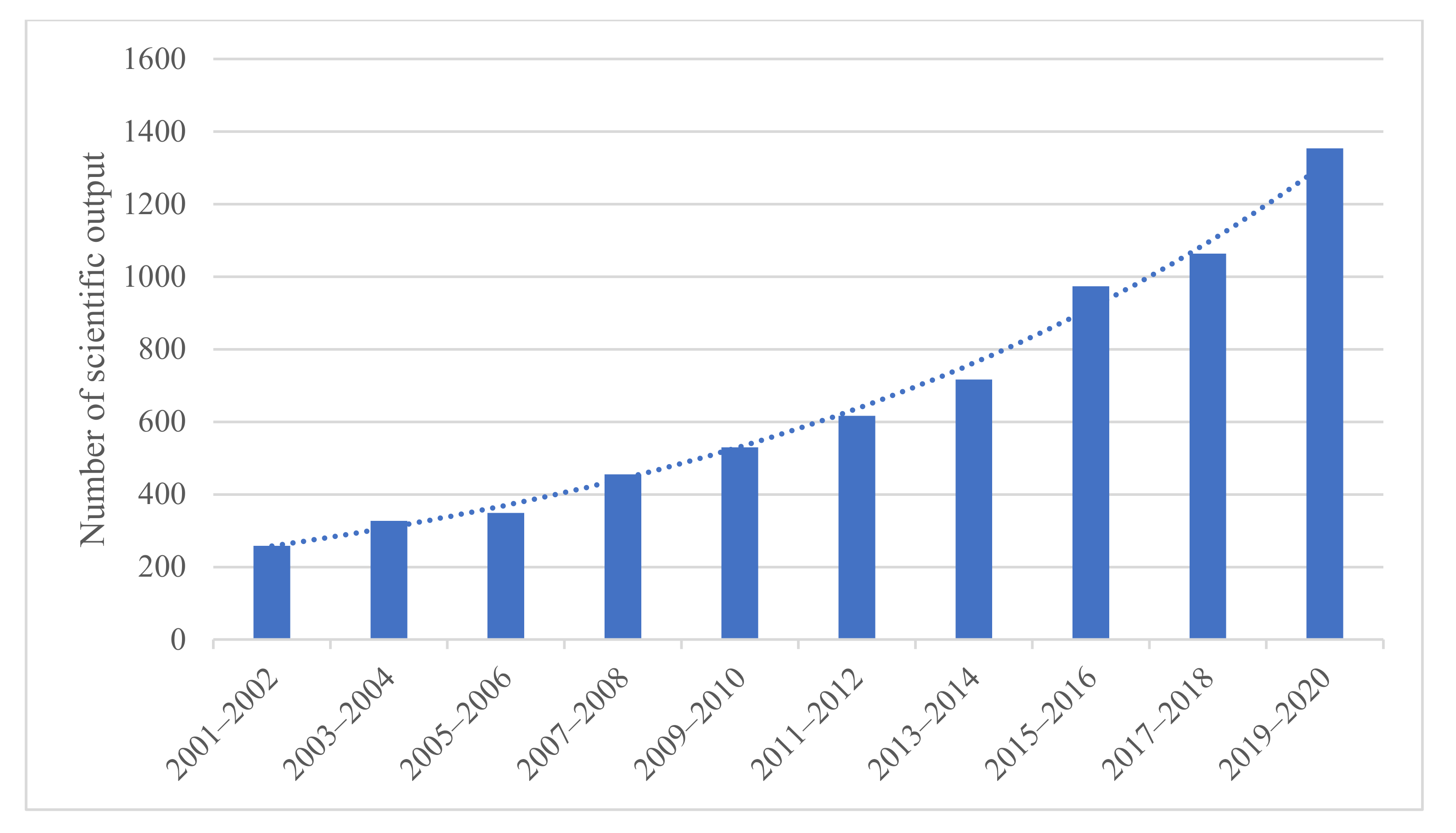

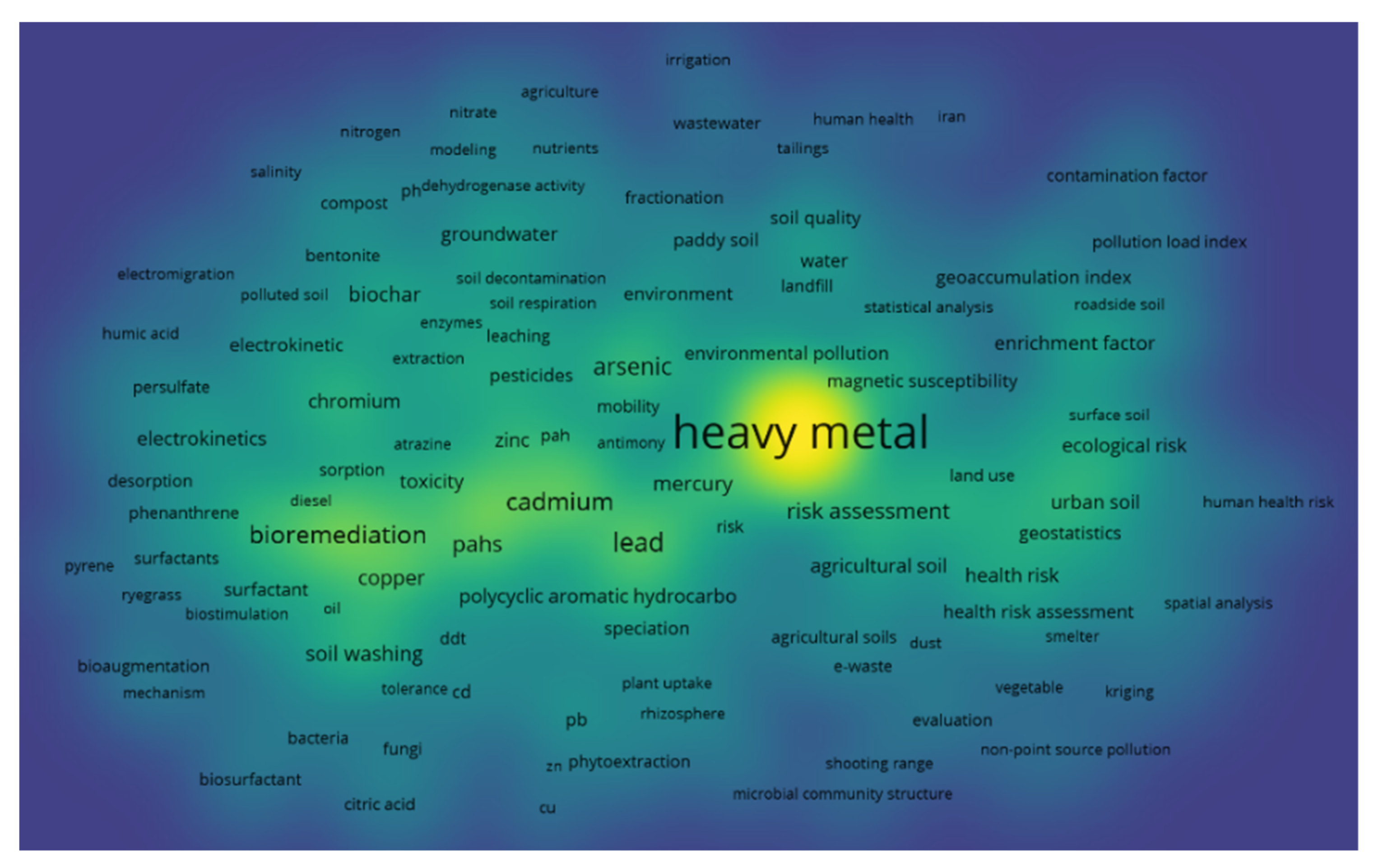
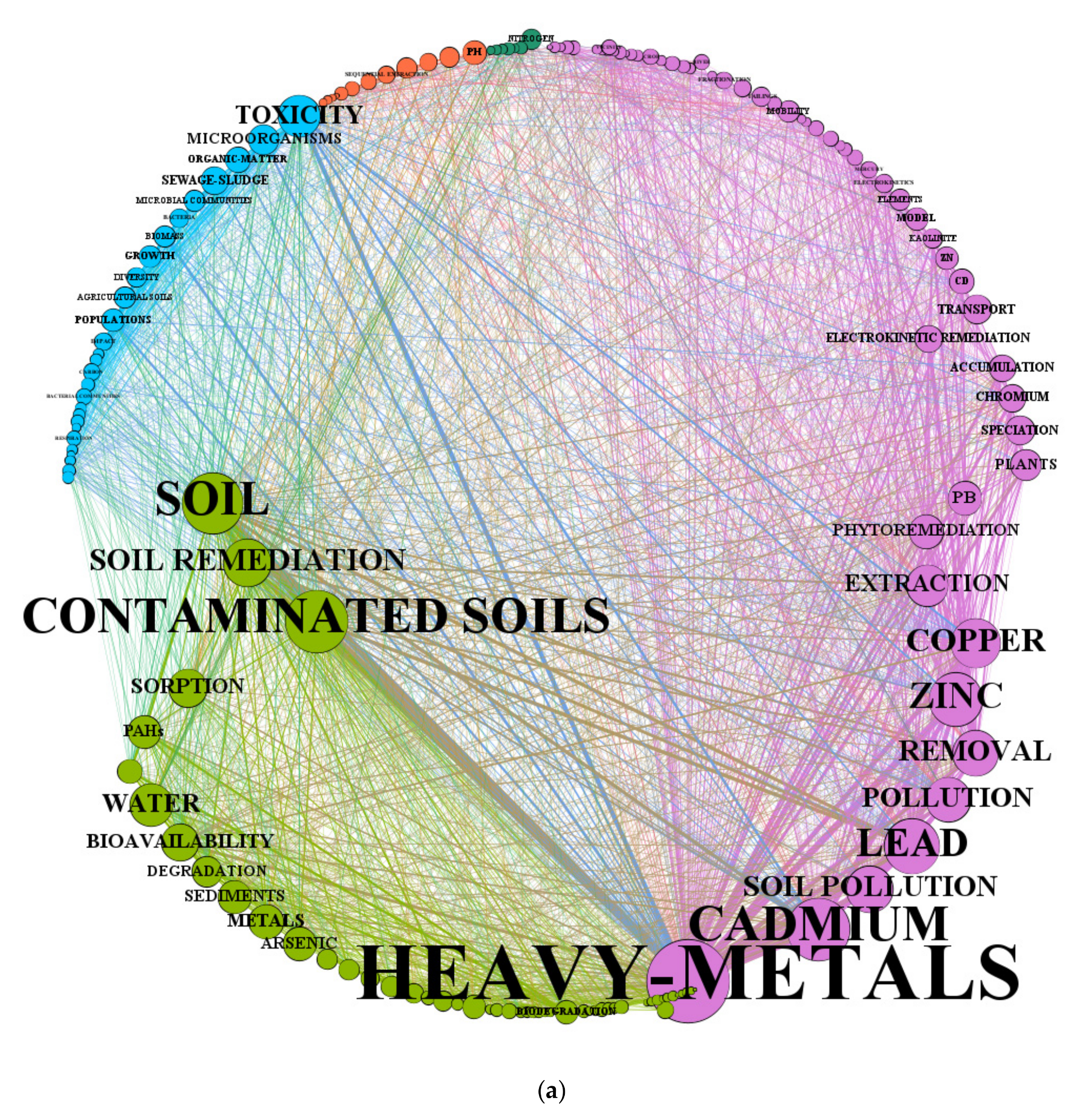
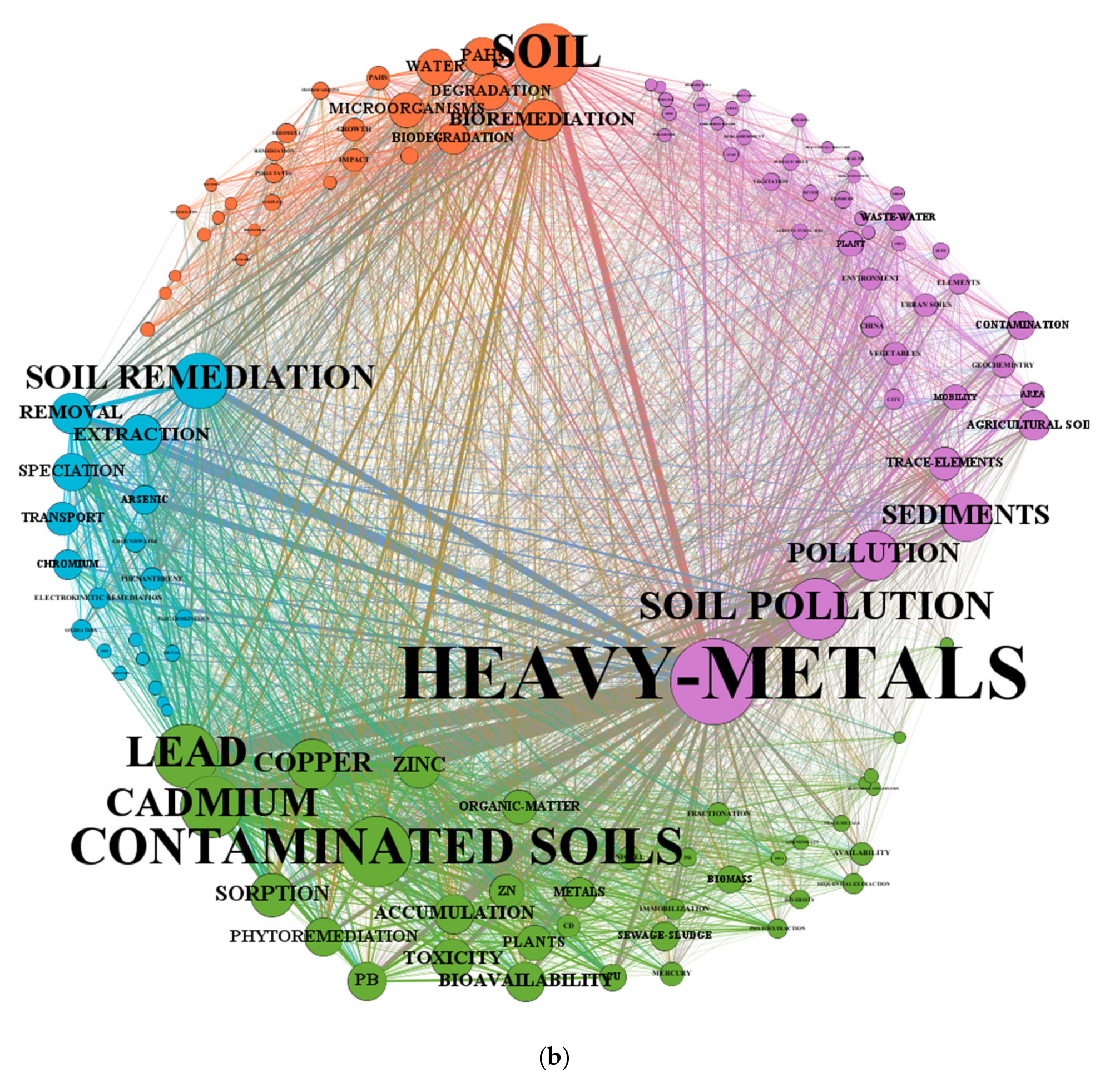
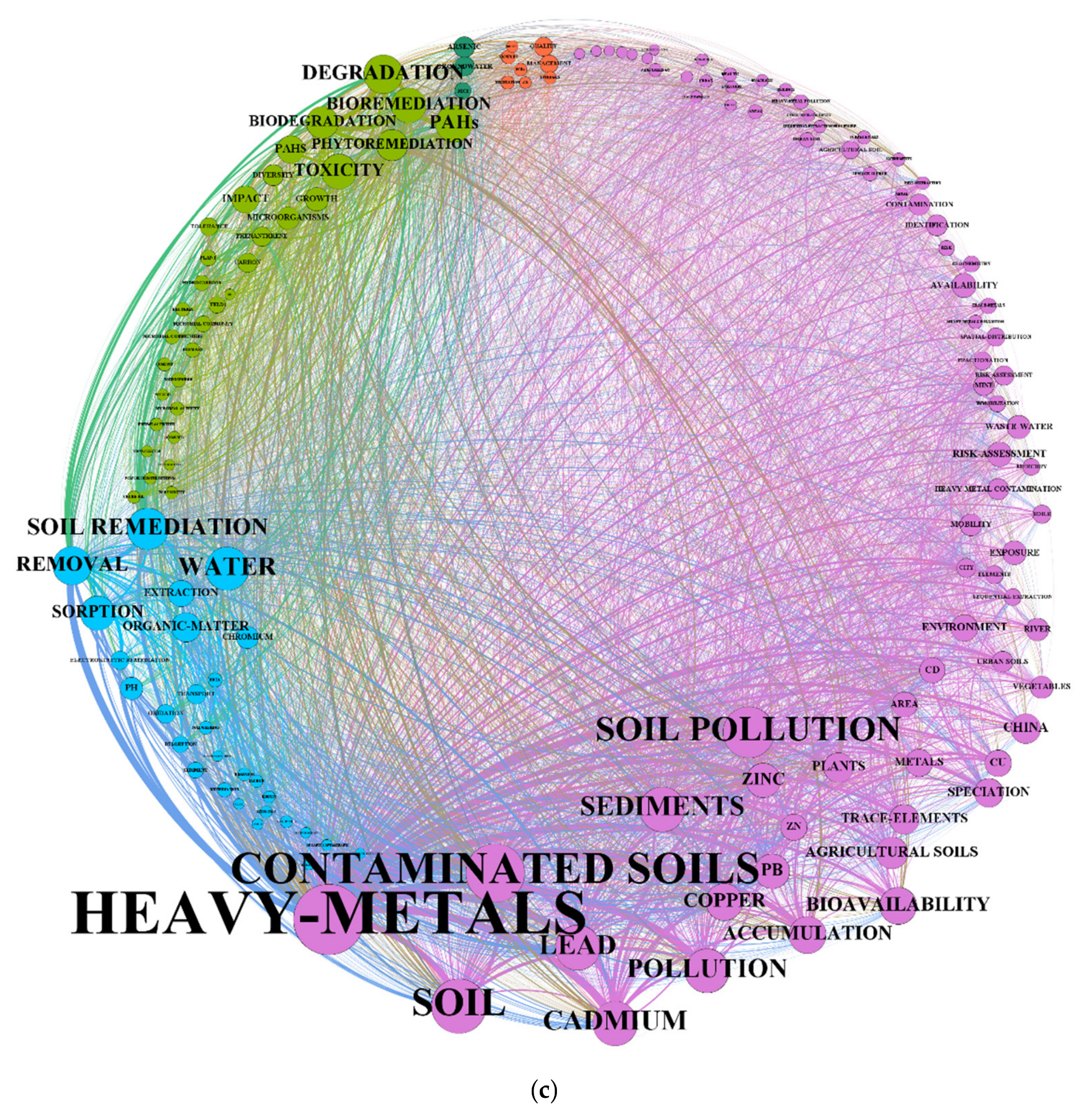
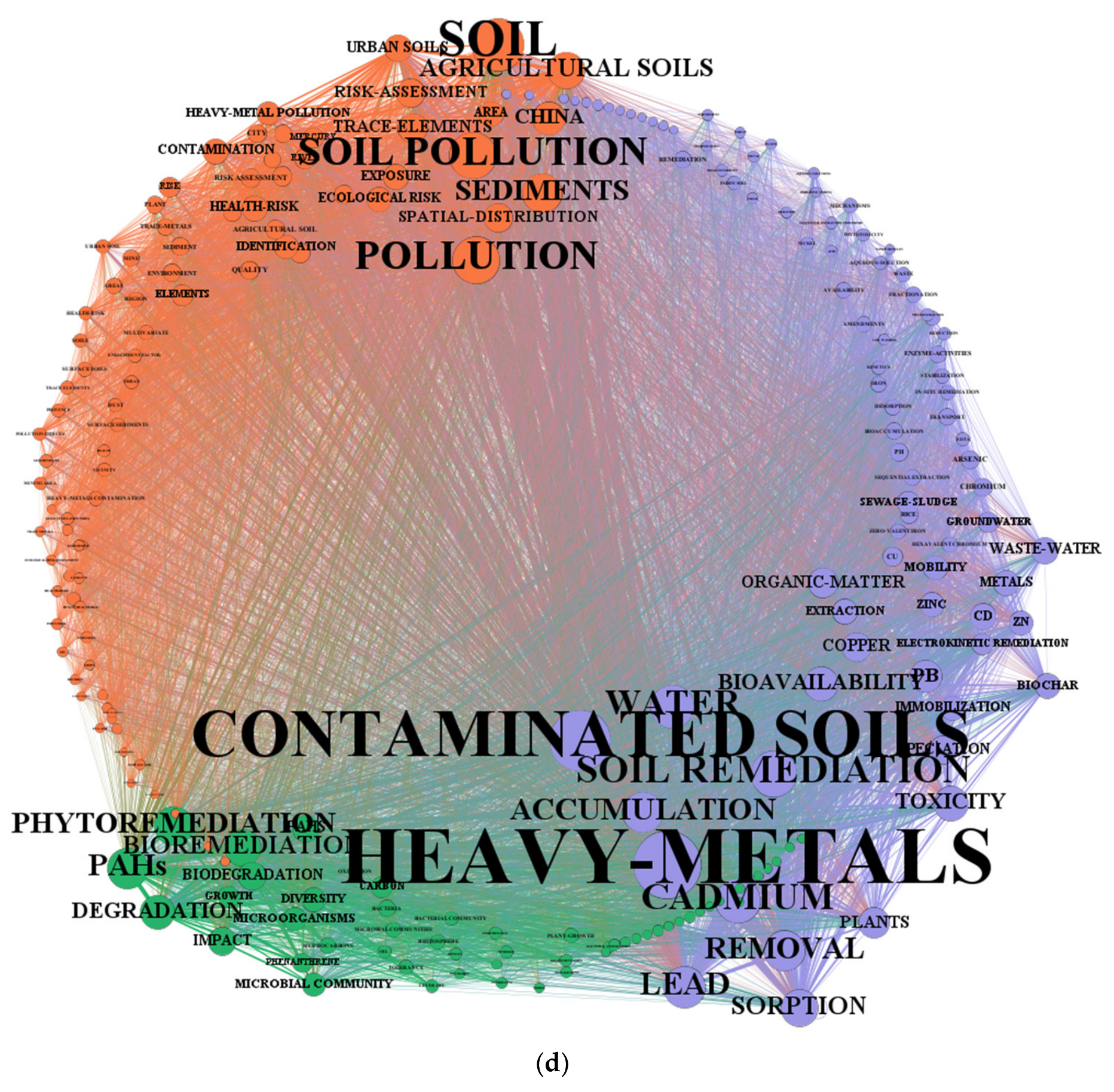
| Order | 2001–2005 | 2006–2010 | ||
|---|---|---|---|---|
| Countries/Region | Frequency | Countries/Region | Frequency | |
| 1 | United States | 147 | China | 203 |
| 2 | China | 56 | United States | 119 |
| 3 | Germany | 48 | Spain | 77 |
| 4 | Canada | 47 | Italy | 64 |
| 5 | Italy | 38 | Poland | 52 |
| 6 | France | 35 | India | 48 |
| 7 | Australia | 34 | Germany | 47 |
| 8 | England | 34 | England | 44 |
| 9 | Poland | 33 | Canada | 43 |
| 10 | Russia | 30 | Japan | 42 |
| 11 | Japan | 30 | France | 38 |
| 12 | Spain | 28 | Russia | 36 |
| 13 | South Korea | 25 | Belgium | 32 |
| 14 | Finland | 21 | South Korea | 31 |
| 15 | Netherland | 21 | Turkey | 29 |
| Order | 2011–2015 | 2016–2020 | ||
| Countries/Region | Frequency | Countries/Region | Frequency | |
| 1 | China | 587 | China | 1136 |
| 2 | United States | 166 | United States | 258 |
| 3 | Spain | 104 | Spain | 156 |
| 4 | Poland | 97 | Russia | 153 |
| 5 | India | 72 | Poland | 150 |
| 6 | Italy | 69 | India | 130 |
| 7 | France | 63 | Iran | 106 |
| 8 | Russia | 59 | Australia | 104 |
| 9 | South Korea | 55 | South Korea | 103 |
| 10 | Australia | 49 | Italy | 89 |
| 11 | Iran | 48 | France | 86 |
| 12 | Japan | 43 | Canada | 72 |
| 13 | Canada | 38 | Germany | 72 |
| 14 | Taiwan, China | 37 | Brazil | 69 |
| 15 | England | 35 | England | 65 |
| Order | 2001–2005 | 2006–2010 | ||
|---|---|---|---|---|
| Institutions | Frequency | Institutions | Frequency | |
| 1 | Chinese Academy of Sciences | 25 | Chinese Academy of Sciences | 59 |
| 2 | Russian Academy of Sciences | 13 | Zhejiang University | 21 |
| 3 | University of Helsinki | 11 | China State Shipbuilding Corporation | 18 |
| 4 | University of Illinois | 11 | Shanghai Jiao Tong University | 16 |
| 5 | Zhejiang University | 10 | Russian Academy of Sciences | 13 |
| 6 | University of Naples Federico II | 9 | University of Illinois | 10 |
| 7 | French National Institute of Agronomic Research | 8 | University of Ljubljana | 9 |
| 8 | Moscow MV Lomonosov State University | 7 | Helmholtz Centre for Environmental Research | 9 |
| 9 | University of Rome La Sapienza | 7 | National Institute for Agro-Environmental Sciences | 8 |
| 10 | U.S. Environmental Protection Agency | 7 | University of Turin | 8 |
| 11 | Spanish National Research Council | 6 | French National Institute of Agronomic Research | 8 |
| 12 | McGill University | 6 | University of Ghent | 8 |
| 13 | Concordia University | 6 | University of Florida | 7 |
| 14 | Kansas State University | 6 | University of Vigo | 7 |
| 15 | Vrije Universiteit Amsterdam | 5 | University of Granada | 7 |
| Order | 2011–2015 | 2016–2020 | ||
| Institutions | Frequency | Institutions | Frequency | |
| 1 | Chinese Academy of Sciences | 133 | Chinese Academy of Sciences | 211 |
| 2 | Beijing Normal University | 34 | University of Chinese Academy of Sciences | 76 |
| 3 | University of Chinese Academy of Sciences | 24 | Zhejiang University | 54 |
| 4 | University of Warmia and Mazury | 21 | Russian Academy of Sciences | 40 |
| 5 | Zhejiang University | 21 | University of Warmia and Mazury | 36 |
| 6 | Russian Academy of Sciences | 21 | Beijing Normal University | 35 |
| 7 | Shanghai Jiao Tong University | 20 | Tsinghua University | 34 |
| 8 | French National Institute of Agronomic Research | 18 | Northwest A&F University | 31 |
| 9 | China University of Geosciences | 18 | Shanghai Jiao Tong University | 30 |
| 10 | Chinese Research Institute of Environmental Sciences | 17 | Chinese Research Institute of Environmental Sciences | 27 |
| 11 | Tsinghua University | 16 | Islamic Azad university | 26 |
| 12 | Nanjing University | 16 | Nankai University | 25 |
| 13 | University of Vigo | 15 | University of Castilla-La Mancha | 23 |
| 14 | Nanjing Agricultural University | 15 | China University of Mining and Technology | 23 |
| 15 | University of Tehran | 13 | China University of Geosciences | 23 |
| Keyword | 2001–2005 | 2006–2010 | 2011–2015 | 2016–2020 | Total Number |
|---|---|---|---|---|---|
| Heavy metal | 121 | 257 | 343 | 582 | 1303 |
| Lead | 24 | 49 | 50 | 72 | 195 |
| Bioremediation | 15 | 39 | 51 | 78 | 183 |
| Phytoremediation | 11 | 29 | 44 | 94 | 178 |
| Cadmium | 19 | 39 | 34 | 69 | 161 |
| Arsenic | 17 | 31 | 38 | 49 | 135 |
| Electrokinetic remediation | 13 | 19 | 39 | 52 | 123 |
| Risk assessment | 6 | 12 | 28 | 56 | 102 |
| PAHs | 7 | 23 | 27 | 38 | 95 |
| Bioavailability | 11 | 15 | 20 | 43 | 89 |
| Soil washing | 9 | 11 | 28 | 39 | 87 |
| Copper | 9 | 19 | 26 | 23 | 77 |
| Mercury | 5 | 14 | 22 | 34 | 75 |
| Spatial distribution | 4 | 4 | 13 | 48 | 69 |
| Biochar | 0 | 0 | 6 | 63 | 69 |
| Year | Title | Journal | Total Cites | Country |
|---|---|---|---|---|
| 2014 | A review of soil heavy metal pollution from mines in China: Pollution and health risk assessment | Science of The Total Environment | 1560 | China Review article |
| 2010 | A review of heavy metal contaminations in urban soils, urban road dusts, and agricultural soils from China | Microchemical Journal | 1406 | China Review article |
| 2014 | Remediation of heavy metal(loid)s contaminated soils—To mobilize or to immobilize? | Journal of Hazardous Materials | 1071 | Australia Review article |
| 2001 | Remediation technologies for metal-contaminated soils and groundwater: an evaluation | Engineering Geology | 1041 | Canada Review article |
| 2011 | A review of biochars’ potential role in the remediation, revegetation, and restoration of contaminated soils | Environmental Pollution | 1036 | UK Review article |
| 2015 | Soil contamination in China: current status and mitigation strategies | Environmental science and technology | 994 | China Review article |
| 2001 | Heavy metal contamination of urban soils and street dusts in Hong Kong | Applied Geochemistry | 945 | China Research article |
| 2001 | Surfactant-enhanced remediation of contaminated soil: a review | Engineering Geology | 774 | Canada Review article |
| 2008 | The mobility and degradation of pesticides in soils and the pollution of groundwater resources | Agriculture, Ecosystems, and Environment | 771 | Spain Review article |
| 2003 | Arsenic contamination of Bangladesh paddy field soils: implications for rice contribution to arsenic consumption | Environmental science and technology | 740 | UK Research article |
| Cluster ID | Size | Related Keywords for Clustering of Co-Cited Documents |
|---|---|---|
| 0 | 35 | soil treatment; electrokinetic soil remediation; electrokinetics; sequential extraction analysis; chelate agents; remedial action; migrate; iodide; speciation; clays; electroremediation; mercury; mitigation; zero-valent iron; organic contaminated soil; heavy metal; sand; electro-osmosis; chelating agent; desorption; cesium; kaolinite; carbonate; mathematical model; remediation technologies; Triton X; pilot-scale electrokinetic remediation; uniform electric field; sandy loam; adsorbent; health risk; pesticides; etc. |
| 1 | 29 | contaminant solubilization; coupling of remediation technologies; enhancement techniques; soil pH control; electrochemical remediation; reductive process; heavy metals; electrokinetics; electrolyte; soil remediation; fractionation; electrolyte conditioning; pretreatment; multi-heavy metals; clay; nitroaromatic contaminant; combined methods; Fenton treatment; chlorinated organic contaminant; integrated Fenton; organic pollutants; Fenton-like treatment; etc. |
| 2 | 29 | urban soils; multivariate statistical analysis; gastric juice simulation test; mobility; soil remediation; multivariate statistics; geo-statistics; GIS; urban road dust; tanneries; anthropogenic activities; integrated pollution index; heavy metal contamination; land use; PCBs; functional area; factor analysis; risk analysis; spatial pattern; integrated contamination index; administrative region; pollution index; roadside soil; pollution load index; etc. |
Publisher’s Note: MDPI stays neutral with regard to jurisdictional claims in published maps and institutional affiliations. |
© 2022 by the authors. Licensee MDPI, Basel, Switzerland. This article is an open access article distributed under the terms and conditions of the Creative Commons Attribution (CC BY) license (https://creativecommons.org/licenses/by/4.0/).
Share and Cite
Gao, J.; Faheem, M.; Yu, X. Global Research on Contaminated Soil Remediation: A Bibliometric Network Analysis. Land 2022, 11, 1581. https://doi.org/10.3390/land11091581
Gao J, Faheem M, Yu X. Global Research on Contaminated Soil Remediation: A Bibliometric Network Analysis. Land. 2022; 11(9):1581. https://doi.org/10.3390/land11091581
Chicago/Turabian StyleGao, Jun, Muhammad Faheem, and Xiang Yu. 2022. "Global Research on Contaminated Soil Remediation: A Bibliometric Network Analysis" Land 11, no. 9: 1581. https://doi.org/10.3390/land11091581
APA StyleGao, J., Faheem, M., & Yu, X. (2022). Global Research on Contaminated Soil Remediation: A Bibliometric Network Analysis. Land, 11(9), 1581. https://doi.org/10.3390/land11091581






